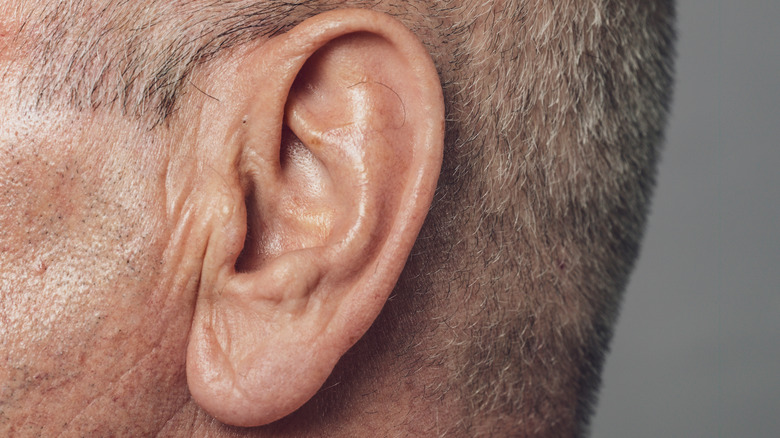Can Your Ears Predict Your Heart Attack Risk? Here's What We Know
Our ears provide us with a lot more than just a canvas for our favorite earrings. Essential for hearing and maintaining balance, our ears are just as important to our health as any other part of the body. Not only that, but these organs may also be able to provide us with clues as to whether or not we may be at risk for cardiovascular health problems. How? Look no further than your own earlobes.
Our earlobes may not look like much at first glance, but they're there for a reason. These fleshy flaps receive ample blood flow, which helps our ears stay nice and toasty (via News Medical Life Sciences). Our earlobes fall into one of two categories: free earlobes or attached earlobes. True to their name, free earlobes dangle freely from the bottom of the ear. In cases of attached earlobes, however, the bottom part of the earlobe remains connected to the head. Whether free or attached, if you notice a crease in the center of your earlobe, research suggests that these individuals may be at an increased risk for heart disease.
The link between earlobe creases and cardiovascular health issues
Known as "Frank's sign," the presence of a diagonal crease that runs across the center of the earlobe has been linked with cases of coronary artery disease (CAD), a risk factor for heart attack (via Head and Neck Pathology). Researchers from a 2006 study published in The American Journal of Forensic Medicine and Pathology studied the bodies of 520 deceased men and women undergoing autopsy exams. Frank's sign was detected in more than half of the autopsy cases. The researchers found a strong connection between earlobe creases and rates of coronary artery disease. For men, there was also a relationship observed between earlobe creases and sudden cardiac death (SCD).
In a more recent 2021 study published in BMC Cardiovascular Disorders, researchers looked at the earlobes of more than 650 patients diagnosed with acute myocardial infarction (AMI), otherwise known as a heart attack. They categorized patients' earlobes by severity of the crease from Grade 0 up to Grade 3. Those ranked as Grade 0 had no visible crease, while individuals ranked as Grade 3 had the longest, deepest earlobe creases. The study team assessed the relationship between earlobe creases and patient survival rates following a heart attack. The findings revealed a statistically significant relationship between earlobe creases and death within one year of experiencing a heart attack.
Earlobe creases are only one potential risk factor for heart disease
The researchers presented several potential causes for this relationship. One theory is that Frank's sign may be a symptom of a microvascular disorder in the earlobe that causes artery thickening and tearing in the elastic fiber (via BMC Cardiovascular Disorders). Collagen breakdown in the skin was also proposed as a potential contributing factor to plaque accumulation in the arteries.
Experts caution that a diagonal crease in one's earlobe should be thought of as only one of many potential risk factors contributing to heart disease rather than a definitive predictor of the condition. Additional risk factors to consider include smoking, a lack of exercise, a poor diet, and more. Researchers in the previously mentioned 2006 autopsy study found that aside from earlobe creases, body mass index (BMI) and age were also two of the main contributing factors shown to play a role in coronary artery disease risk. Other studies have found no existing relationship between earlobe creases and heart disease risk (via JAMA Internal Medicine). Instead, some experts believe that the correlation between the two lies in the fact that rates of skin creases and heart issues tend to increase in older adults.



